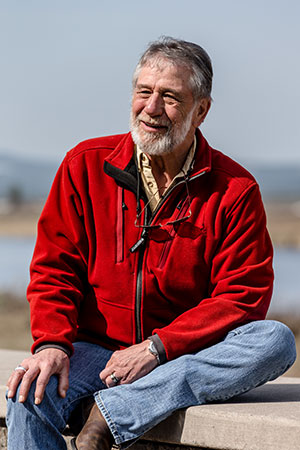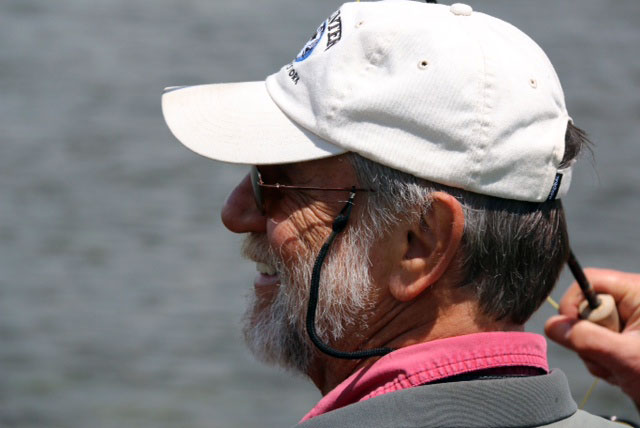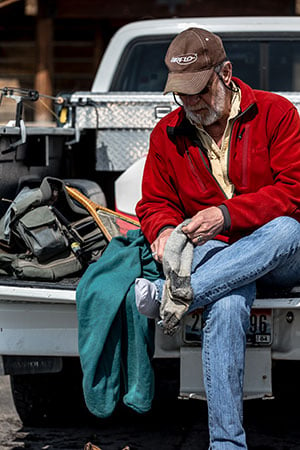Interview with Rene Harrop
In the course of a lifetime, I have heard the voices and met the ghosts who guard the sacred places. Although forceful in their presence and insistent in their will, they have never told me what not to do. But sometimes, when I stray from what is important and what is real, they tell me who I am.
– René Harrop (Trout Hunter, 2004)

photo by Bryan Gregson
In June 2004, I was 21 years old and living in a camping trailer at the Buffalo Run RV Campground in Last Chance, Idaho. I waited tables at a fishing lodge bar situated on the banks of the Henry’s Fork.
Everyone passed through that bar, it seemed—fire crews and biologists, bootleggers and investment bankers, anglers and writers, the crux of America’s off-the-radar humanity. For the most part, I served burgers to fly fishing lunatics and listened to their tales of epic trout and legendary hangovers. But then there was René.
René was a Western romance writer’s dream-come-true. He was half Indian, adopted as an infant by a white family and raised in an Idaho Mormon town. His family never told him of his heritage; he didn’t know he was Blackfoot and Lakota Sioux until age forty, when the truth found him. But that’s René’s story to tell, not mine.
Every night you could find him on an old two-track that ran parallel to the river, parked in his white 1979 Chevy Scottsdale to watch the sun go down with his wife, Bonnie. After sunset, they would come in the bar and order steaks and beer. Most of the time he was reserved, inquiring about your day or family. But other times, he would throw a curve.
One evening, I was filling waters at the bar. Rene cornered me there, requesting a beer. The evening hatch of caddis over the Henry’s Fork caught the last light of day in hovering white sparks over the water that shone through the window as the sun fell behind the Divide, behind the Centennial Range, into Montana. He stood across from me and asked: “Young lady, have you ever seen a skinned bear?”
I thought on it. I recalled as a kid in rural Pennsylvania poking at colossal black bears sprawled in the beds of hunters’ pick-ups parked outside the Mennonite store; fat pink tongues flopped from their slack mouths. I recalled boar pelts tacked spread-eagle to the wall alongside whitetail mounts, traditional backwoods living room décor. But the remains of a skinned bear, never.
“No,” I said, “I can’t say that I have.”
I slid the Natural Light across the bar.
He cracked the can with thick nicotine fingers as if he were snapping a femur, the same fingers that could tie a PMD spinner as fine as a Fabergé egg.
“Well, know that a skinned bear looks just like a person. Just like you and me.” I nodded my head in sincerity to let him know that this knowledge was more than fair trade for a cheap, cold beer, but wondered at the gravity at his tone, what he knew about a dead bear that I didn’t. Besides, when would I ever see such a thing?[1]
He walked away with an air of vagueness before I could ask questions, leaving me with a few crumbs to brush from the bar.
* * * * * * *
SARAH GRIGG: You and I have never once discussed fishing and I don’t plan to break that tradition here.
RENÉ HARROP: Agreed. Let’s not.
SG: You’re a prolific writer and you write things that probably surprise your audience at times, like that quote above from Trout Hunter—mixing mystical insights with a how-to on tying an elk hair caddis. How do you stand behind that, talking like a medicine man to a broad audience?
RH: I wrote periodically in the 1970s through 2000. Most of the assignments were for magazines and because so much of my writing was directed toward Japan, especially in the 1990s, there was an interest in Native American culture. “Dances with Wolves” had just come out and that brought a lot of energy and attention overseas. Because I have that ancestry, readers were hopeful that I could provide a perspective on life and on living in this part of the world, including fishing. What that did was give me an opportunity to explore areas that were beyond just the nuts and bolts of fishing. Dogma is a curse that we try to avoid, and that was one way of avoiding it.

photo by Bonnie Harrop
That quote came from the only specific writing I did for the book. Everything else was a pre-published article. For me, it was never structured and I just started telling the history of my life and carrying it through the early beginnings of being a young boy here on the Henry’s Fork and taking it to that point. I’ve had so many experiences here because I’ve been receptive to forces that touch people in this part of the world that are hard to explain and certainly to understand. It was something that came out of my internal consciousness, reaching back into something that wasn’t really planned, it was just there.
SG: Fly tying and angling haven’t always been your primary professions. What other occupations have you held?
RH: My college schooling ended after two years with marriage. In 1966 I was barely 21 and I was hired by an insurance company, Prudential Life. I was fortunate because to support a family I needed something like that. It forced me to relocate to what I consider a city, that is, Idaho Falls, seventy miles south. I found myself unhappy to be away from my home, which is here, on the mountain. I didn’t make it long and took a job in a sawmill and moved back north.
The days were really long and I couldn’t wait to get away from the noise of the saws. It was hard work. A lot of times at lunch break, I would drop my hardhat and head to the river. You know, it was an unusual time and timing is everything. By standards then, it was a good job and it was what people did, but I knew it wasn’t for me.
From there it progressed from tying flies part-time to make ends meet and teaching Bonnie to tie. And then things just fell into place; that kind of opportunity was available. At that time, the best flies were tied by individual tyers here in the States and everything coming from overseas was cheap and poorly made. It’s something that could never be repeated, not by today’s industry standards with foreign-tied flies.
SG: So you started in Old West and now find yourself in the New West, that is, within the recreational industry. And you find yourself a born-and-bred Westerner in the midst of a global community. Where does the West lie, Rene? On some honky-tonk dance floor?
RH: I reflect on this a lot. I’ll be 70 soon and that’s a lot of years to spend in one place and a lot of opportunity to make that comparison. Logging and timber were huge, as was the ranching and livestock industry. Individualism was incredibly apparent in the culture and the society. The freedom that went with it was a gift. It’s a struggle for a person to look back and realize now how much more difficult it is ever really find ourselves alone—there are eyes on everything we do and in those days there just weren’t. It was rugged and wild. When I was a youth, a Saturday night without a few fist fights outside the Silver Horseshoe in St. Anthony was a pretty boring night. You found yourself in those situations looking for a good time and today you would go to prison for that kind of behavior.
There’s so much nostalgia and anger. And I’m sad to say this, because anger isn’t an exaggeration of how I see a generation of people who are very resentful toward what’s happening and the restrictions being placed upon them—with our public resources particularly, the land and the activities that were once allowed and accepted are no longer possible. I understand the anger, because there are times when I’m reflecting, being nostalgic, I recall those times with fondness. But that’s in part because I was a younger person, a younger man.
Was it better then? Is it better now? There are too many times that people can’t look forward into the younger generations and the futures that they have. It’s been easy for me, as a grandfather, great-grandfather. I can say “thank goodness” we aren’t doing the things we were doing fifty years ago. Some people can’t get over the idea that this isn’t the Old West anymore. But it’s gone. It’s a bygone era.
SG: But what are the parts that stand still? What always finds you?
RH: Going into places like the Divide and places that are very, very wild . . . There are places that are energy charged, a different kind of energy. And I think because it’s different, we notice that when we go into those remote places, places that are the same as when my ancestors were mining obsidian out of the Centennials. We sense the footprints, the tools along the trail—those are the lasting artifacts of time. That’s what that quote [above] began with. Those energies are preserved and I guess if you have the superstitious nature of a person like me, you don’t have to work too hard to find those places. I don’t think you have to have a long, deep history. The hair stands up on the back of your neck and you know you’re in a powerful place. It just takes a little receptivity.
When you move fast, without the idea of paying attention, that’s when you miss things. The idea of hunting trout or big game animals, the mentality is the same: one of slow pace, observance, mindfulness. I find when I’m wading in the Henry’s Fork, time disappears. I’m wading in the same space in 2014 as I was in 1954. I’ve witnessed the changes; they’re not abrupt. Maybe an island has worn away at the edges over time, but the mind-state is the same.
SG: Your adopted father was sent off to France during World War II and returned to a child that was not his. Your mother never told you who your real father was. But nobody ever told you?
RH: I didn’t know my history. It was hidden from me. Much of my life, I felt dishonest because of that. I didn’t suffer because of it, but there was something I wanted to pin down that I couldn’t. I was a wild, reckless man without understanding. There was an unconscious, a collective unconscious, that I tapped into and felt but that I couldn’t identify. It took me until I was 40 to learn who I was. Just knowing who we are is a big accomplishment.

photo by Bryan Gregson
But growing up, I was always drawn to the Reservation [in Fort Hall]. I spent a lot of time down there. One day I was driving around looking for a funeral. It was a ceremony for a chief and I wanted to pay respect. I came across a very old man in a veteran’s uniform walking along the road. He was heading to the same funeral and he knew where it was and took me there. He became my teacher. He was old, born in the late 1890s.
He knew I liked to fish and would talk about the Bannock Trail, which ran along the river. The rivers were the highways. He would talk about how excited he was as a child to come north, to the mountains. He always asked about the Big Insect, and by that, he meant the salmonflies. It was a food opportunity for his family. They would pick them like berries from the grass, gather them in buckets, roast the bugs, pound them into a meal and eat them. As fishermen we look at salmon flies with hunger in our eyes, so we think. In this part of the world, these meanings still collide.
Just in the 1960s, you could go to Blackfoot and it was clear that the traditional way of life was still very intact. They resisted houses. They’d cut holes in the roof to let out the smoke from their fires.
SG: What are you working on now and how does the identity of who you are now tie into it?
RH: At my age, it’s lucky to have such an opportunity to communicate. Most people don’t want to hear an old man’s thoughts or words and I’m lucky to be doing what I’m doing. Right now, I’m working on another book, In the Shadow of the Centennials. I was fishing in a creek at the base of the mountains and I looked up and saw what I wanted to say. Shadows fall away from the Centennials in all directions. From the top of Sawtelle [a prominent peak in the range meaning “The Chief”], I can see where most of my life has been spent. I want to return to a tone for writing that is more about living, just being here. It won’t be a connected chapter-to-chapter read. I don’t like chronological time.
SG: Last question: What else do you know about a bear, dead or alive, that I don’t?
RH: In the legends, every animal occupies more than one identity; they can take on multiple forms, different physical presentations of themselves. These different forms offer different lessons. It explains why we can’t learn things about certain animals, why they remain elusive to us, because they change form. We may not be able to get what we are looking for, but it helps explain what we cannot find.
SG: Thank you, René.
RH: Hey.
SG: Yes?
RH: I want you to write this down. Are you ready?
SG: Yes.
RH: I think we have to identify where we want to live. It’s one of the most important objectives a human can have. Maybe it’s where you’re born and maybe it’s not. But you have to find a home. You don’t have to be creative. You have to be determined. The future of important places is dependent upon a generation of people who came from somewhere else. The pace of change for me has been like the river, gradual. For you, for my grandchildren, it’s so fast. But you have to find your place and you have to hang onto it.
This, right here, is a place that will embrace you or kill you. And I’ve seen both sides of that. It keeps us alert to the responsibilities we have. But everything has come to me here. I haven’t had to go out and look for it. By the grace of the people who come here, it has all arrived on my doorstep.
[1] As luck would have it, I would see a skinned bear, four years later, in the heart of the Caribou-Targhee National Forest, in the Centennial Range, the place into which the sun sank over the Divide every night. Through a stand of Douglas firs, in a deep mountain drainage, that is where I saw the bear: in the place where grizzlies go to die. I looked at that skinned beast, the pink and red striations of flesh as unrecognizable to me as cuts of meat sprawled under a glass case in a butcher shop in a foreign land, a grizzly that had stepped on a land mine. It’s a story that cannot be told without a handle of Jack and several hours to spare, a story for another time.











